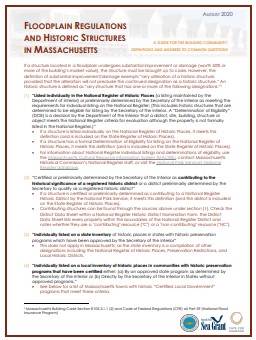- Definitions
- Certified Communities
- FAQs
Definitions
An historic structure is defined as any structure that has one or more of the following designations:
Listed individually in the National Register of Historic Places (a listing maintained by the Department of Interior) or preliminarily determined by the Secretary of the Interior as meeting the requirements for individual listing on the National Register; (This includes historic structures that are determined to be eligible for listing by the Secretary of the Interior. A “Determination of Eligibility” (DOE) is a decision by the Department of the Interior that a district, site, building, structure or object meets the National Register criteria for evaluation although the property is not formally listed in the National Register.)
- If a structure is listed individually on the National Register of Historic Places, it meets this definition (and is included on the State Register of Historic Places).
- If a structure has a formal Determination of Eligibility for listing on the National Register of Historic Places, it meets this definition (and is included on the State Register of Historic Places).
- For information about National Register individual listings and determinations of eligibility, use the Massachusetts Cultural Resource Information System (MACRIS), contact Massachusetts Historical Commission’s National Register staff, or visit the National Park Service's National Register database.
Certified or preliminarily determined by the Secretary of the Interior as contributing to the historical significance of a registered historic district or a district preliminarily determined by the Secretary to qualify as a registered historic district
- If a structure is certified or preliminarily determined as contributing to a National Register Historic District by the National Park Service, it meets this definition (and the district is included on the State Register of Historic Places).
- Contributing structures can be found through the sources above under section (1). Check the District Data Sheet within a National Register Historic District Nomination Form. The District Data Sheet lists every property within the boundaries of the National Register District and notes whether they are a "contributing" resource ("C") or a "non-contributing" resource ("NC").
Individually listed on a state inventory of historic places in states with historic preservation programs which have been approved by the Secretary of the Interior
- This does not apply in Massachusetts, as the state inventory is a compilation of other designations including the National Register of Historic Places, Preservation Restrictions, and Local Historic Districts.
Individually listed on a local inventory of historic places in communities with historic preservation programs that have been certified either: (a) By an approved state program as determined by the Secretary of the Interior or (b) Directly by the Secretary of the Interior in States without approved programs.
Definitions from Massachusetts Building Code Section R105.3.1.1 (2) and Code of Federal Regulations (CFR) 44 Part 59 (National Flood Insurance Program)
Towns with Historic “Certified Local Government” Programs
- Bedford
- Boston
- Brookline
- Danvers
- Eastham
- Easton
- Falmouth
- Framingham
- Gloucester
- Grafton
- Hingham
- Holyoke
- Lexington
- Lowell
- Marblehead
- Medfield
- Medford
- Methuen
- New Bedford
- Newton
- Plymouth
- Quincy
- Salem
- Somerville
- Worcester
Frequently Asked Questions
Does the substantial improvement/damage exemption for historic structures mean ALL floodplain requirements are waived?
- The exemption can be interpreted as an exemption only from those flood mitigation activities that would preclude the structure’s historic designation (recommended) or a complete exemption from all flood mitigation. The local Building Commissioner may make this determination but should do so consistently for all qualifying historic structures.
What does it mean to “preclude a structure’s historic designation”?
- Certain physical features (such as roof forms, entries, and architectural detailing) typically qualify a structure for listing on a historic register. When these features are changed, the historic designation can be rescinded (or precluded). Therefore, these features must be preserved in order to maintain the substantial improvement exemption. These features are typically described in the documentation for a structure’s historic designation, which can be found through the Massachusetts Cultural Resource Information System (MACRIS), by contacting Massachusetts Historical Commission’s National Register staff, or visiting the National Park Service's National Register database.
In Barnstable County, the Cape Cod Commission’s Historic Preservation Specialist is available to provide an opinion on what might preclude a structure’s historic designation.
Does a qualifying historic structure need a variance from the Massachusetts building code?
- No. If a structure meets the definition of an historic structure above, it is exempt from substantial improvement requirements by definition. Therefore, a variance is not required to issue a local permit even if the proposed structure does not meet floodplain standards. However, documentation of the qualifying historic designation should be kept on file.
What if a qualifying historic structure triggers the “substantial repair of a foundation” requirements in the Massachusetts Building Code?
- There are no specific exemptions for historic structures from the “substantial repair of a foundation” requirements. However, the local Building Commissioner is given flexibility to determine what floodplain mitigation may be waived to preserve the structure’s historic designation. The Building Commissioner should seek input from the State Inspector with the Office of Public Safety and Inspections on a case by case basis.

